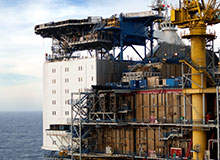
Delta 2 is a small field developed near the Oseberg oil and gas field located around 130km west of Bergen, Norway, in the northern part of the Norwegian North Sea. Delta 2 is developed as a satellite to the Oseberg field.
The Oseberg field, operated on Blocks 30/6 and 30/9 of the Norwegian North Sea, has undergone multiple phases of development since it was brought on-stream in 1988. It is operated by Statoil, with a stake of 49.3%. The other partners in the development are Petoro (33.6%), Total (14.7%), and ConocoPhillips (2.4%).
The plan for the development and operation of the Delta 2 field was submitted to the Norwegian Ministry of Petroleum and Energy in May 2013. The investment for the Delta 2 development was Nkr7bn ($1.2bn approximately). The oil field started production in February 2015.
Delta 2 fast-track development project
Delta 2 was one of the fast-track developments by Statoil on the Norwegian shelf. The fast-track development programme is aimed at recovering resources closer to existing fields through faster small field developments, utilising the existing infrastructure. The Delta 2 fast-track development decision was taken in December 2011.
Delta 2 field discovery
The Delta 2 oil and gas field in the Oseberg South area was discovered in 2008. The exploration well 30/9-21S was drilled by Transocean Winner. The field was estimated to contain approximately 16m barrels of recoverable oil equivalents.
Delta 2 geology and reserves
The Delta 2 reservoir consists of middle Jurassic sandstones of the Brent Group. It is located 3,100m beneath the seabed.
The field is estimated to contain 77 million barrels of oil equivalent (BOE), 32 million BOE of oil and 45 million of gas.
Delta 2 field development plan
Delta 2 is developed at a water depth of 100m. The field development is based on the use of two seabed templates. The production of the field is sent to the Oseberg Field Centre via two insulated rigid pipelines.
The subsea equipment is installed as part of the Delta 2 development project include five wellheads, five subsea trees, and two subsea manifolds.
The field produces up to 18,000 BOE a day for a field life of around 20 years.
Existing Oseberg field centre infrastructure
The Oseberg field centre in the southern part of the Oseberg field consists of three bridge-interlinked platforms, Oseberg A, B, and D.
The Oseberg A concrete base platform is a process and accommodation facility. The Oseberg B steel jacket platform features drilling, production and injection equipments. Oseberg D is a steel platform with gas processing and an export facility.
Oil and gas from a range of fields, including Oseberg Øst, Oseberg Sør, Tune, Oseberg Vestflanke, and Oseberg Delta is processed at the field centre facilities.
Oil and gas transport from Oseberg and Delta 2
Oil from the Oseberg field is transported to the Sture terminal through the Oseberg Transport System. The gas produced from the field is sent to market via the Oseberg Gas Transport pipeline and into the Statpipe and Vesterled systems via the Heimdal Gas Centre.
Contractors involved with Delta 2 field development
FMC Technologies was awarded a $152m contract in December 2012 to supply the subsea equipment, including manifolds, wellheads, trees, and control systems for the Delta 2 project.
Subsea 7 was responsible for pipe-lay and subsea installations at Delta 2 after winning a $160m contract in February. The company designed, fabricated and installed two rigid production pipelines measuring 10km in length, constructed and installed two flexible gas injection lines totalling 9km, installed two umbilicals totalling 16km, installed the manifolds and also performed the tie-in work.







